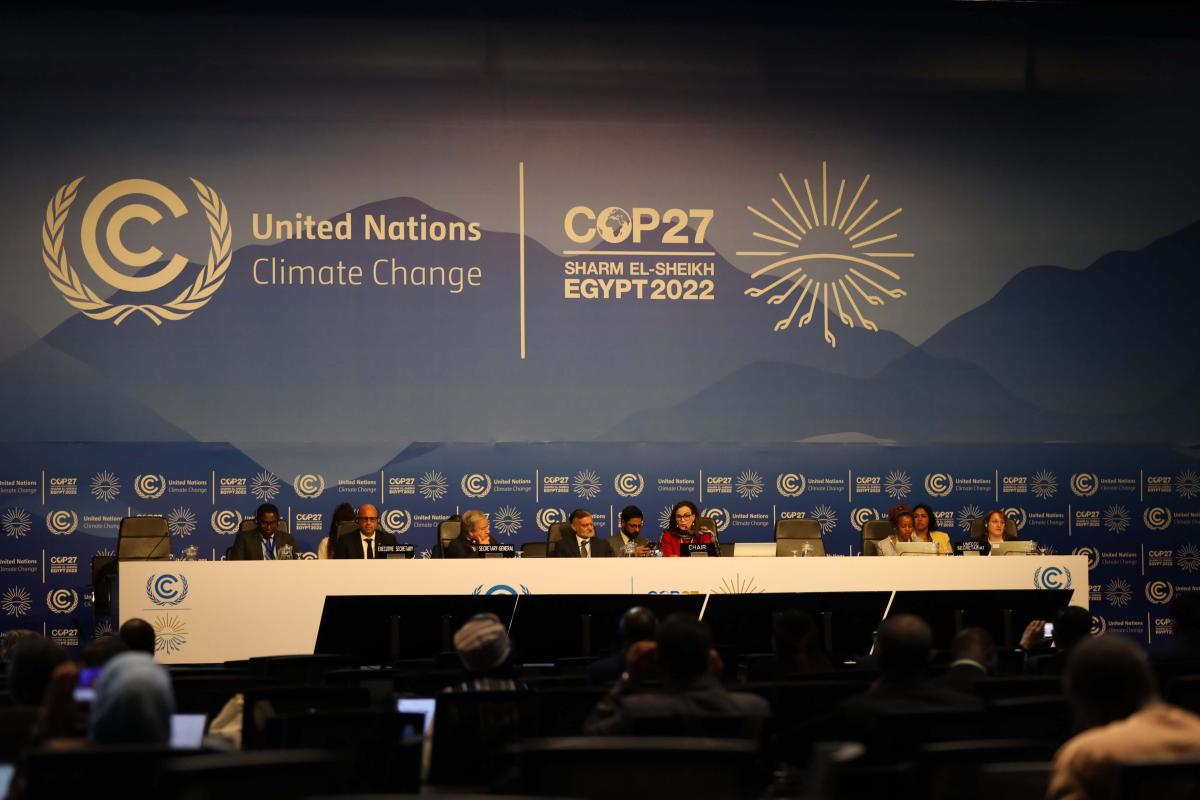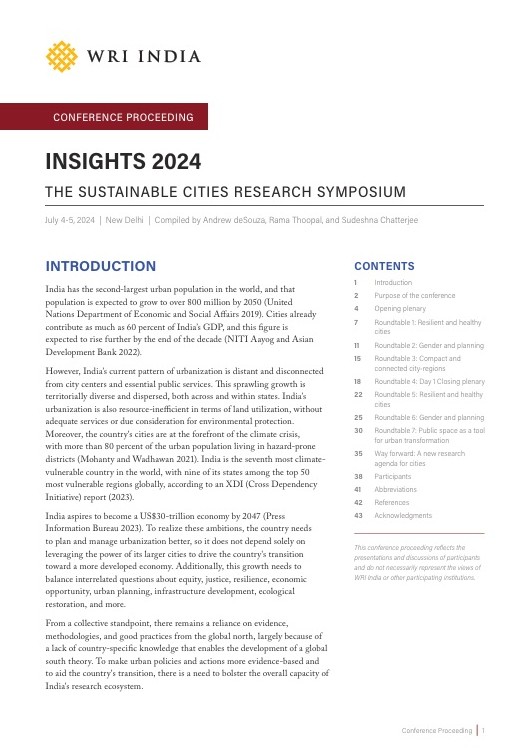Deconstructing COP27 for India

The UN Climate Change Conference (COP27) held in Sharm el-Sheikh, Egypt, concluded with delegates reaching an agreement to establish a fund for Loss and Damage to help vulnerable countries deal with the severe impacts of the climate crisis. Despite the urgent need for countries to adopt ambitious climate actions aligned with science, COP27 saw no major developments to accelerate mitigation. The developments also fell short of ramping up the adaptation finance to double by 2025 — as envisioned in COP26. While the implications of COP27 will be felt for decades to come, in this interview we focus on the key takeaways from the two-week event and what it means for India.
Aditi Sundan (with support from Anandi Mishra) speaks with experts from WRI India’s Climate program — Ashwini Hingne, Deepthi Swamy and Subrata Chakrabarty — to help us parse through the key developments at COP27 and how they translate for India. You can watch the interview here:
Read edited excerpts from the interview here:
1. The focus of COP27 was on implementation. What role can India play, especially with respect to its Nationally Determined Contributions (NDCs)?
Deepthi: Globally, the latest science tells us that we are currently not on track to limit temperature rise to 1.5 degrees Celsius by the end of the century. In the best-case scenario, the world can limit temperature rise to 1.8 degrees Celsius, if current unconditional NDCs and net zero targets are met. To meet this optimistic scenario, it is critical to align 2030 NDC targets with long-term net zero targets. India’s Long-Term Strategy launched at COP27 affirms the long-term goalpost of achieving net zero emissions by 2070. Moreover, it lays down a sectoral approach for policy actions and acknowledges the need for a just transition and reskilling measures, along with the need for international finance support.
Our modeling indicates that for a low-carbon development pathway that is consistent with the goal of net zero emissions by 2070, large-scale electrification plays an important role, even in the near term in 2030. The projected electricity demand for 2030 in this scenario would need to be met with about 340 GW of non-fossil sources (at least 60% of the total capacity). This is higher than the updated NDC target of 50% of non-fossil fuel share in electricity capacity by 2030, and a significant increase from the current non-fossil fuel capacity of 171 GW in absolute terms. Additionally, India will need to deploy decarbonization measures across other emission-intensive sectors, such as transport, industries, and construction. Therefore, detailed sectoral implementation roadmaps with near-term milestones between 2020–2050 are key to unlocking the emissions reductions required for a net zero pathway.
2. At COP27, negotiators finally decided to set up a loss and damage facility. Why is loss and damage important, what does it mean for developing countries like India and what are some questions about the fund that remain to be answered?
Ashwini: COP27 decided on establishing a loss and damage fund and institutionalizing the Santiago Network to help address climate change induced losses of life, land, income, biodiversity, or ecosystem services or damages to health, homes, and properties that cannot be avoided either by emissions reduction or adaptation to climate change impacts. This can be viewed as a breakthrough, especially considering the decades-long resistance from developed countries against any compensation or liability. It is also a significant first step in ensuring climate justice and global solidarity for vulnerable communities suffering from climate impacts despite their relatively low contribution towards climate change, compared to industrialized nations and advanced economies. However, several questions need to be answered before the fund can deliver what vulnerable communities need.
- Who pays: Developed countries have managed to keep the language non-specific on who pays. The final text uses the term “widen the sources” to presumably include large developing countries such as China and India, as well as international financial institutions, multilateral development banks, and contributions from the private sector
- Who gets paid: After several iterations, countries settled for “developing countries that are particularly vulnerable” – a terminology that excludes no one but also tries to prioritize countries that may be in most need of the fund. However, it leaves the room open for disagreements on which countries are “particularly vulnerable”.
- What is the quantum of the fund: Estimates suggest that the economic costs of loss and damage in developing countries alone will range between 290 and 580 billion USD a year by 2030. The extent to which this fund will be able to meet such requirements remains to be seen.
- How does the money get disbursed: 70% of the commitments made by individual countries on loss and damage focus on the Global Shield — an insurance-based finance mechanism that has been criticized for being inequitable and inadequate in addressing slow onset impacts and non-economic loss and damage from climate change. Ensuring needs-based and tailored finance is critical for the fund to deliver on its objective.
- When do the funds flow: A “Transitional committee” has been instituted, which will meet three times before COP28 to discuss some of these questions and provide recommendations on operationalizing the facility.
While the new loss and damage fund made headlines, this COP also institutionalized the Santiago Network. The Santiago Network aims to connect developing countries with providers of technical assistance, knowledge and resources required to address climate risks comprehensively in the context of averting, minimizing and addressing loss and damage.

3. There has been a lukewarm response to mitigation and ambition at COP this year. With the 1.5 degrees Celsius goal seeming farther than ever, how does the lack of ambitious mitigation and emission targets fare for the global response to the worsening climate crisis?
Subrata: Let me start with the Mitigation Work Programme (MWP) that was conceptualized at COP26 to urgently scale up mitigation ambition and implementation. Interestingly, the final text that was agreed upon at COP27 does not have any connection to COP26. Thus, any aspects of monitoring the progress on the pledges that were made by the countries at COP26 are disregarded. Further, the MWP does not impose any new targets or goals, recognizing the nationally determined nature of all countries’ commitments. The final text also does not agree on the year by which global emissions should peak.
The bright spots are that the MWP will: (a) inform future COP decisions; (b) start immediately and will inform the annual high-level ministerial roundtable to strengthen and implement climate targets in this decade; and (c) hold global dialogue among governments to identify investment opportunities and means to access climate finance.
Unfortunately, for many countries and civil society organizations, the text on ambition was not bold enough. Following the call for ambition made at COP26 – where we saw 30-odd countries responsible for one-fifth of the global share of emissions, submit their revised or updated NDCs – the response from parties until now, has been rather disappointing. COP27 also failed to include the phase down of all fossil fuels.
4. Climate finance has been a key issue for developing countries at COP. What does it mean in terms of climate justice? What do you think are the shifts needed in climate finance to support developing countries?
Subrata: There is no definition of climate finance within the United Nations system, which makes it difficult to monitor the flow of climate finance. One of the pending negotiation issues was to mobilize an annual sum of USD 100 billion since 2020, a target that is yet to be met by developed countries. The COP27 cover text simply expresses the concern that this target is not met. The final text on adaptation finance urges the developed countries to double their collective provision of climate finance for adaptation.
Discussion on a new climate finance target for after 2025 has been deferred for two more years. The only outcome on finance, is the call to shareholders of multilateral development banks and international financial institutions to reform their practices and priorities, develop new instruments, scale climate finance significantly and make it accessible to those who need it.
5. Another contentious issue on the agenda this year was that of the rules negotiating carbon markets under Article 6 of the Paris Agreement and their implementation. What developments took place on this issue?
Ashwini: Article 6 is technical and has been the most contentious issue in the past few years. Article 6 of the Paris Agreement lays out cooperative approaches to meeting the global climate goal through trading of emissions reductions. Article 6.2 refers to carbon trading (called “internationally traded mitigation outcomes”) between countries to meet their Paris Agreement targets. Article 6.4 establishes an international carbon market to facilitate the sale of emission reductions from projects to meet national climate goals or regulatory compliance.
While the broader rules for Article 6 were completed at COP26 in Glasgow after much delay and negotiations, the focus in COP27 was on defining the operational requirements and procedures while ensuring real, permanent and traceable reductions that avoid double counting.
Particularly, under Article 6.2, one of the important topics on the agenda was reporting requirement – what to report and what could be confidential. The final text now allows countries to keep any information confidential. Although the text suggests that parties disclose the basis for confidentiality, the language (“should”) does not mandate or require them to do so. This is a big setback for transparency and accountability for transactions under Article 6.2, rendering the expert review process inconsequential, risking the integrity of the reductions being claimed and the confidence in market-based approaches. While there were other issues, including retrospective revocation of internationally traded mitigation outcomes, some decisions on procedures are now left for COP28.
Subrata: Article 6.4 is about creating a new international carbon market, which will allow countries, businesses or individuals to trade carbon credits or Emissions Reductions (ERs) under the supervision of the Conference of Parties.
Just before the start of COP27, the Article 6.4 supervisory body provided recommendations to include carbon removals within its trading mechanism. The definition of removals under this is quite broad with no distinction between types of removals. Removals are not greenhouse gas (GHG) emission reductions and unless implemented well, they come with considerable risks to the rights of indigenous communities, ecosystems, etc. The recently released Land Gap Report also reveals that not enough land is available to realistically consider removals in line with the 1.5 degrees Celsius goal. The supervisory body recommendation also mentions engineering-based carbon removal approaches, such as direct air capture, carbon capture and storage. As these technologies are expensive and at a nascent stage in many countries, they won’t scale up ambition and would instead lock in fossil fuel infrastructure.
Another issue was that of the non-authorized carbon credits and their double counting. Not clearly defined at COP26, last year saw non-authorized ERs being left out of the “corresponding adjustments” that are made to emission inventories of trading parties to avoid double counting. COP27, however, defined non-authorized ERs as “mitigation contribution Article 6.4 ERs”, which can be used to meet the host party’s domestic climate targets. This implies that using them for any other purposes would amount to double counting.
On the transfer of ‘Certified Emission Reductions (CERs)’ from Clean Development Mechanism (CDM) to Article 6.4 mechanism, parties agreed that the emission reductions originated after 2013 can be used towards meeting first or updated first NDCs. However, these emission reductions will not be subjected to “corresponding adjustments”, which could lead to double counting.

6. What are your key takeaways and concluding remarks for this year’s COP?
Deepthi: The establishment of a just transition work program at COP27 is a welcome addition. However, we need further work on operationalizing it at a country level. The development of indicators for measuring just outcomes and their integration into financing plans, such as the Just Energy Transition Partnership (JETP), along with the inclusion of labor groups and marginalized communities in consultative processes for designing investment plans would be critical to channeling funds to the adversely affected groups in the transition. Moreover, it is important to increase the share of grants in funding for a just transition to ensure that the financing is not limited to clean energy projects with a return on investment but can also be used to mitigate the adverse distributional impacts of the transition.
Ashwini: Despite some underwhelming outcomes on mitigation and ambition, COP27 was the first one to recognize and note the right to a clean, healthy and sustainable environment that mentioned food, nature-based solutions, and sustainable lifestyles and emphasized the need for a just and equitable transition in the decision text. The outcome on loss and damage is also a testament to what civil society, small countries and non-state actors can achieve when they work together and demand what is right. Yet, it is important to remember that countries have only agreed to create a fund, and important questions on how much, by whom, to whom, by when and how, remain unanswered.
Subrata: While the negotiations on carbon markets yielded modest results, we saw a few encouraging developments outside the negotiations. For example, Government of Ghana has officially authorized the transfer of carbon credits to Switzerland under its climate-smart rice project. On the market side, several initiatives came up, including the Africa Carbon Market Initiative which aims to scale up quality carbon credits in Africa and generate employment and other sustainable development benefits.
All views are personal.


